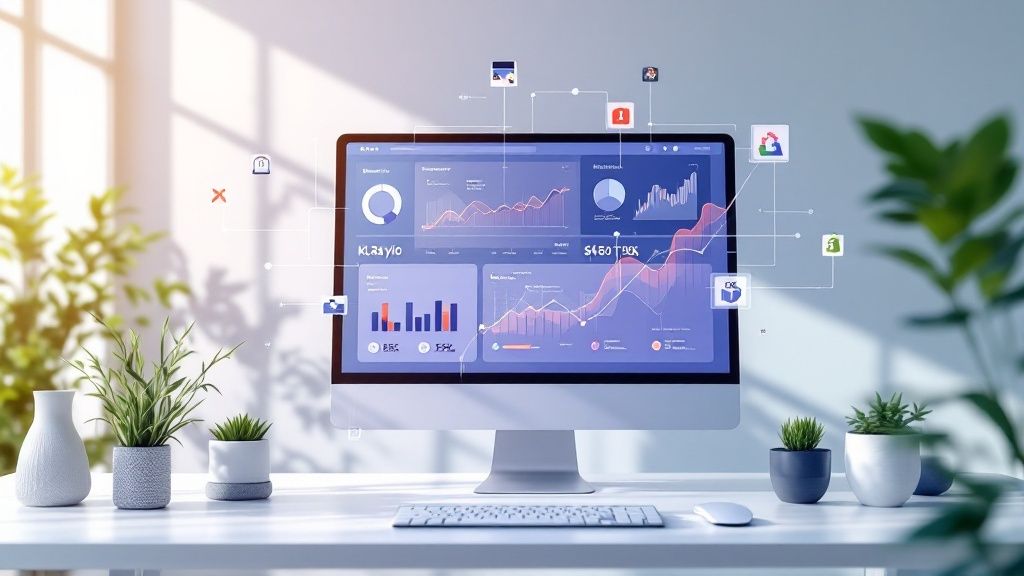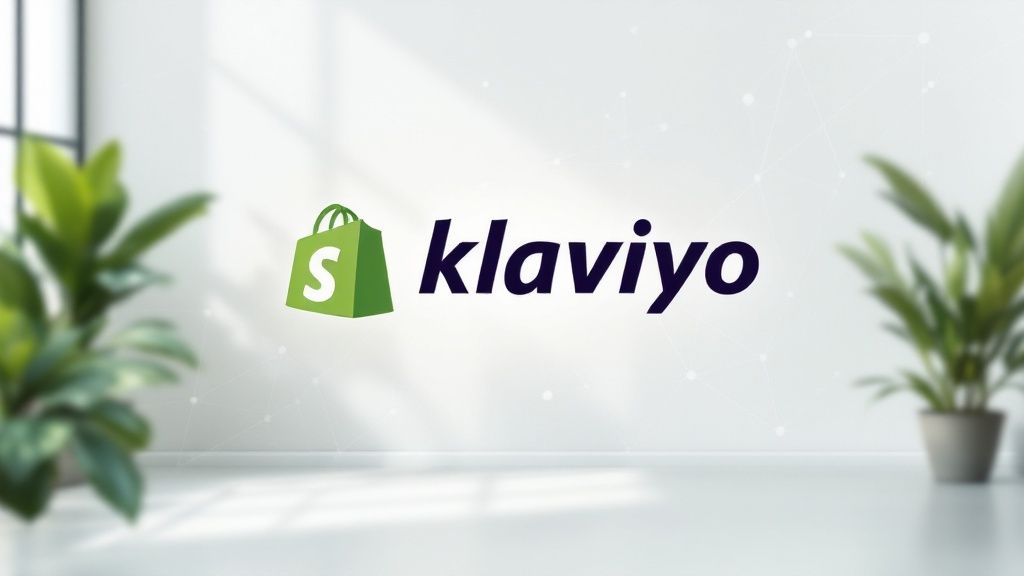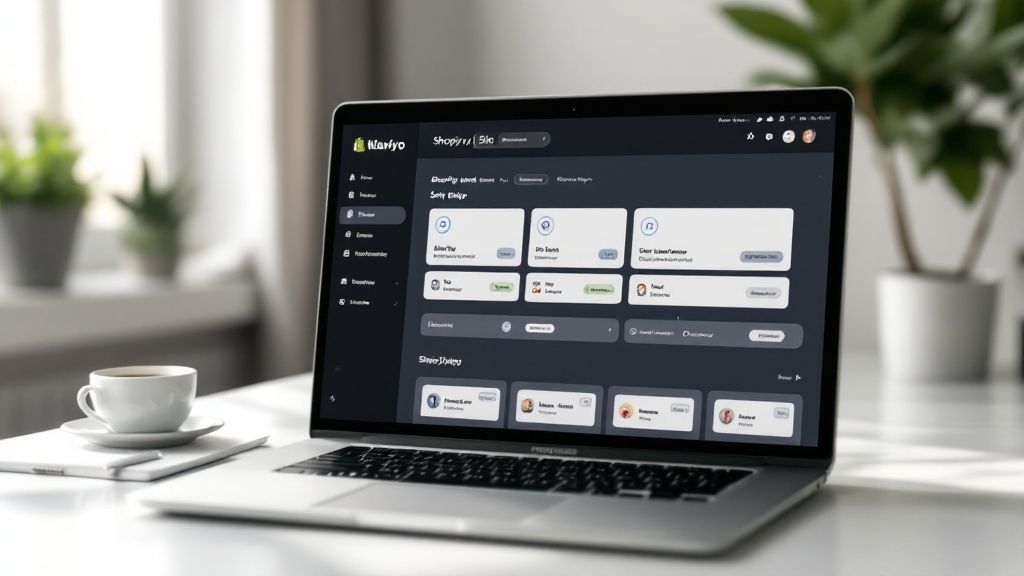Klaviyo Shopify Integration: Boost Your Store Sales
April 18, 2025

Why Klaviyo Shopify Integration Changes Everything

Effectively marketing your online store can be challenging. Many merchants struggle to connect with customers personally, often relying on generic email blasts that yield minimal results. This is where the Klaviyo Shopify integration makes a significant difference, shifting your marketing approach from guesswork to a precisely targeted strategy. It empowers you to build genuine customer relationships, leading to increased sales and long-term loyalty.
The Power of Real-Time Data
This integration creates a powerful data ecosystem by seamlessly connecting your Shopify store with Klaviyo's marketing automation platform. Imagine having instant access to customer behavior, purchase history, and browsing patterns.
This real-time data flow addresses common online retailer frustrations, allowing you to personalize customer interactions at every touchpoint. This leads to a critical point: merchants using this integration often outperform their competitors.
This isn't just anecdotal; data supports this observation. Shopify brands using Klaviyo see an average 62% growth in gross merchandise volume (GMV). This impressive statistic highlights the synergy between these two platforms. Klaviyo's integration with Shopify efficiently syncs the last 90 days of customer data, enabling you to engage recent customers immediately.
Real-time metrics, such as checkout starts, orders placed, and product views, are crucial for targeted campaigns. Learn more about the power of this integration: Klaviyo Shopify Integration Details
Personalized Experiences That Convert
Personalization is key to effective marketing. With the Klaviyo Shopify integration, you can segment your audience based on specific behaviors and preferences. This means that instead of sending generic emails, you can tailor your messages to resonate with individual customer profiles.
This targeted approach dramatically improves open rates, click-through rates, and ultimately, conversions. Imagine sending a personalized email featuring recently viewed products or offering a discount on items related to past purchases.
These tailored interactions create a more engaging customer experience, fostering loyalty and driving repeat business. This personalized approach helps convert casual browsers into loyal customers, fostering sustained growth.
Building a Sustainable Growth Strategy
The Klaviyo Shopify integration provides a robust foundation for sustainable growth. By leveraging real-time data and personalized messaging, you can build stronger customer relationships.
This allows you to nurture these relationships over time, leading to increased customer lifetime value and a thriving business. Furthermore, the integration empowers you to automate crucial marketing tasks, freeing up your time to focus on other essential business aspects.
This combination of personalized experiences and automated efficiency is a recipe for long-term success in the competitive e-commerce landscape.
Setting Up Your Integration Without Headaches

Connecting your Shopify store to Klaviyo doesn't have to be intimidating. This section provides a clear walkthrough of the integration process, simplifying each step. We'll guide you through the key settings and offer practical tips to avoid common problems.
Installing The Klaviyo App
First, install the Klaviyo app directly from the Shopify App Store. This establishes the initial connection between the two platforms. Once installed, you'll be prompted to log in to your existing Klaviyo account or create a new one, linking your Shopify store to the correct Klaviyo instance.
Configuring API Permissions
After connecting your accounts, you'll need to configure the API permissions. This authorizes Klaviyo to access specific data from your Shopify store. Granting the correct permissions is crucial for proper function. Be sure to allow access to vital data points like customer information, order history, and product details.
Verifying The Connection And Data Transfer
After configuring permissions, verify the connection. Klaviyo typically begins syncing your Shopify data automatically, including the last 90 days of customer activity. Confirm this by checking the data flow within your Klaviyo account. Klaviyo uses secure connections to protect your customer information during synchronization.
Troubleshooting Common Issues
Even with a straightforward setup, issues can occasionally arise. For example, some merchants find certain customer profiles show as "Never Subscribed" despite opting into marketing emails. This might be due to list settings defaulting to double opt-in, requiring subscribers to confirm via email. Switching to single opt-in might resolve this, although each option has its pros and cons. For other issues, contact Klaviyo's support team.
To help streamline your integration process, we've prepared a checklist summarizing the key steps and potential issues:
Klaviyo Shopify Integration Checklist
A comprehensive checklist of all steps required to successfully integrate Klaviyo with Shopify
| Integration Step | Description | Completion Time | Common Issues |
|---|---|---|---|
| Install Klaviyo App | Install the app from the Shopify App Store | 5 minutes | App installation errors |
| Connect Klaviyo Account | Log in to your Klaviyo account or create a new one | 2 minutes | Account connection issues |
| Configure API Permissions | Grant Klaviyo access to necessary Shopify data | 5 minutes | Incorrect permissions granted |
| Verify Data Sync | Confirm Klaviyo is syncing Shopify data | 10-15 minutes | Data sync delays or failures |
| Configure List Settings | Adjust opt-in settings as needed | 2 minutes | "Never Subscribed" errors |
This checklist provides a quick reference for ensuring a smooth integration. Addressing these points will minimize potential problems.
Maintaining Your Integration
As both platforms regularly release updates, maintaining your integration is essential. This ensures ongoing functionality and access to new features. Watch for update notifications and follow recommended procedures. Periodically review your API permissions and data sync to ensure everything remains correctly configured. This proactive approach prevents future issues, allowing you to focus on leveraging the Klaviyo and Shopify integration. For Shopify stores seeking deeper integrations, consider exploring Checkout Links to enhance your workflows.
Turning Customer Data Into Marketing Gold

Successfully integrating Klaviyo with Shopify is more than simply connecting two platforms. It's about transforming raw customer data into personalized marketing gold. This section explores the valuable customer insights gained from syncing Shopify with Klaviyo and shows how successful brands leverage this data to craft resonant campaigns.
Understanding The Data Flow
The Klaviyo Shopify integration unlocks a treasure trove of customer information, including purchase history, browsing behavior, and email engagement. This data empowers you to segment your audience effectively, leading to dramatically improved open rates and conversions.
For example, knowing a customer's past purchases allows you to recommend relevant products, boosting the chance of a repeat purchase. Understanding browsing patterns helps identify potential interests and personalize messaging accordingly.
Segmentation Strategies That Work
Strategic segmentation is key to maximizing your marketing impact. One effective method is segmenting customers by purchase frequency. This allows you to tailor messages for loyal customers versus first-time buyers.
- Create targeted welcome series for new customers.
- Develop exclusive offers for repeat buyers.
Further segmenting by product categories or average order value offers even finer control over your messaging, resulting in highly personalized customer journeys.
Automating and Personalizing Customer Interactions
A major advantage of integrating Klaviyo with Shopify is the power to create personalized, dynamic customer interactions. Klaviyo provides over 60 pre-built flows and 150 email templates customizable with data synced from Shopify.
This allows businesses to automate essential processes like abandoned cart recovery and welcome flows, boosting customer engagement and revenue. Targeted flows, triggered by events like "Placed Order" or "Added to Cart," enable real-time, personalized responses to customer actions. This combination of automation and data-driven insights helps convert one-time buyers into loyal, repeat customers. Klaviyo's advanced segmentation further refines targeting, ensuring relevant and engaging messages. Learn more: Klaviyo and Shopify Integration
Crafting Dynamic Content
Dynamic content blocks personalize messaging based on individual customer profiles, eliminating the need for countless template variations. A welcome email, for instance, could dynamically display products based on browsing history.
This personalized touch significantly enhances customer engagement. Dynamic blocks can also showcase targeted promotions or content related to past purchases, making each interaction more relevant. You might find this helpful: How to master email marketing best practices
Maintaining Data Quality and Respecting Privacy
Accurate, clean data is fundamental for effective segmentation and personalization. Regular data audits ensure accuracy and compliance with privacy regulations.
Respect customer privacy by providing clear opt-in/opt-out options and being transparent about data usage. Prioritizing data quality and privacy builds trust and a positive customer experience, laying the groundwork for long-term email marketing success.
Building Automated Flows That Actually Convert

Now that you understand the power of personalized data, let's explore how to build automated flows within your Klaviyo Shopify integration that truly drive conversions. This involves crafting effective email sequences that resonate with your customers at every stage of their journey. These automated workflows are essential for maximizing revenue and building lasting customer relationships.
Essential Automated Flows
Several key automated flows consistently deliver strong results for Shopify stores. Let's explore some of the most impactful options.
-
Abandoned Cart Flows: These target customers who add items to their cart but leave without completing the purchase. A timely email reminding them of their selected items can be highly effective. Consider including a small incentive, like free shipping or a discount, to further encourage the sale. Checkout Links can enhance these flows by providing personalized links that pre-fill the customer’s cart and automatically apply discounts.
-
Welcome Series: A well-crafted welcome series introduces your brand to new subscribers. Showcase your best products and highlight compelling offers. This is your first impression, so make it count! Personalization based on signup source or browsing history can significantly improve engagement and turn browsers into loyal customers.
-
Post-Purchase Flows: After a customer makes a purchase, a post-purchase flow is an excellent opportunity to encourage repeat business. This might include product recommendations based on their purchase, exclusive offers for repeat customers, or even requests for product reviews. These actions nurture customer loyalty and increase lifetime value.
Timing, Messaging, and Incentives
The effectiveness of your automated flows hinges on a few key factors. Timing is crucial. For abandoned cart emails, sending the first message within one hour can be highly effective. Subsequent emails can be spaced out over a few days.
Messaging should be concise, engaging, and relevant to the customer’s actions. Incentives like discounts or free shipping can be powerful motivators. However, be sure to consider your profit margins and industry standards when offering these perks.
Testing and Optimizing
Continuously testing and optimizing your flows is essential for maximizing conversions. A/B test different subject lines, email content, and incentive strategies. Analyze the results and refine your approach based on what resonates best with your target audience.
Tools like Checkout Links can streamline this process by providing detailed tracking data and facilitating the creation of different link variations for testing. This data-driven approach ensures your automated flows remain effective and continue to drive revenue growth.
Example Flows and Performance Benchmarks
To help you gauge potential performance, we've compiled some general benchmarks. Keep in mind that actual results will vary across industries. The table below offers a helpful comparison:
High-Converting Klaviyo Flow Comparison: Performance metrics and recommendations for essential automated marketing sequences.
| Flow Type | Average Open Rate | Average Conversion Rate | Recommended Number of Emails | Optimal Timing |
|---|---|---|---|---|
| Abandoned Cart | 45% – 60% | 5% – 15% | 3-4 | First email within 1 hour, then 24 hours, and 72 hours after abandonment |
| Welcome Series | 50% – 70% | 2% – 5% | 2-3 | First email immediately after signup, then spread out over a week |
| Post-Purchase | 40% – 50% | 1% – 3% | 1-2 | First email 1-3 days after purchase, second email (if applicable) a week later |
This table provides a starting point for understanding the potential of each flow type. Use this data to inform your strategy and set realistic expectations for your own results. By leveraging the Klaviyo Shopify integration and implementing these strategies, you can transform your email marketing into a powerful engine for growth. Remember to continuously analyze your data, adapt to changing customer behavior, and utilize tools like Checkout Links to further enhance your automation efforts.
Mastering Product Recommendations That Boost Sales
The Klaviyo Shopify integration offers more than basic email marketing. It unlocks the potential for intelligent product recommendations that significantly boost sales. Leading Shopify merchants use this integration to increase average order values through strategic cross-selling and upselling. This section explores how to sync product data, create dynamic recommendation blocks, and choose the right algorithms for your store.
Syncing Product Data for Personalized Recommendations
Effective product recommendations rely on accurate, up-to-date product data. The Klaviyo Shopify integration automatically syncs your product catalog. This includes details like product titles, descriptions, images, pricing, and inventory levels. This real-time synchronization ensures recommendations are always relevant and reflect current availability.
For example, if a product goes out of stock, it won't be recommended. This prevents customer frustration and lost sales. This automated data flow forms the foundation for creating dynamic recommendation blocks that resonate with individual customer preferences.
Creating Dynamic Recommendation Blocks
Klaviyo allows you to build dynamic recommendation blocks within your emails and other marketing materials. These blocks automatically populate with product suggestions based on various algorithms and criteria. You can customize these blocks to match your brand's aesthetics and control the number of products displayed. This allows you to seamlessly integrate product recommendations into your existing marketing campaigns, increasing the likelihood of additional purchases.
Imagine sending an abandoned cart email that not only reminds the customer about the items they left behind, but also suggests complementary products or similar items. This targeted approach can significantly increase the chances of converting the abandoned cart into a sale. Tools like Checkout Links can further enhance these recommendations. They can pre-fill the customer's cart with suggested products and offer personalized discounts, streamlining the purchase process.
Choosing the Right Recommendation Algorithm
Klaviyo offers several recommendation algorithms, each designed for specific use cases. The "Best Sellers" algorithm is a great starting point, showcasing your most popular products. The "Recently Viewed" algorithm targets customers based on their browsing history, reminding them of products they've shown interest in.
The "Items Often Bought Together" algorithm is powerful for cross-selling. It suggests complementary products based on other customers' purchase patterns. For example, if a customer adds a camera to their cart, this algorithm might suggest a memory card or camera bag. Choosing the right algorithm depends on your specific goals and the nature of your products. Testing different algorithms and analyzing their performance is key to finding what works best for your store and customers.
Testing, Measuring, and Refining Your Approach
Continuously testing and refining your product recommendations is crucial for maximizing their impact. Track key metrics like click-through rates, conversion rates, and average order value to measure the effectiveness of different algorithms and placements. This data-driven approach helps identify areas for improvement.
By understanding which products resonate with specific customer segments, you can further personalize your messaging and maximize both immediate sales and long-term customer value.
Taking Your Integration Beyond the Basics
The Klaviyo Shopify integration offers a powerful foundation for email marketing. But for merchants aiming for exceptional results, understanding its advanced capabilities is key. This section explores how to push the boundaries of this integration, transforming your marketing from good to outstanding. We'll delve into custom event tracking, API leverage, predictive analytics, and multi-channel segmentation, all designed to create truly seamless customer experiences.
Custom Event Tracking: Capturing Unique Interactions
Standard Shopify integrations track basic events like purchases and abandoned carts. However, truly understanding your customers requires going deeper. Custom event tracking allows you to capture unique interactions specific to your business. For example, if you offer a product customization feature, you can track which options customers select.
This granular data unlocks powerful insights into customer preferences. This means understanding what resonates most with your audience and tailoring your marketing accordingly for increased engagement and sales.
Leveraging Klaviyo's API: Creating Sophisticated Automation
The Klaviyo API, alongside your Shopify data, opens doors to advanced automation. Imagine triggering a follow-up email based not just on an abandoned cart, but on the specific products left behind, their value, or even the customer's loyalty tier. This level of personalization strengthens customer relationships and elevates your marketing strategy.
You might be interested in: How to master increasing Shopify sales. Integrating tools like Checkout Links can further enhance these workflows by dynamically inserting pre-filled checkout URLs based on cart contents. This creates a frictionless experience, encouraging customers to complete their purchase.
Predictive Analytics: Anticipating Customer Needs
Forward-thinking brands leverage predictive analytics to anticipate customer needs. By analyzing purchase history and browsing patterns, Klaviyo can predict which products customers are likely to be interested in next. This allows you to proactively recommend relevant products, creating personalized experiences that drive conversions and customer satisfaction.
Instead of reacting to past actions, you can anticipate future behavior, creating a proactive marketing approach.
Multi-Channel Segmentation: Reaching Customers Where They Are
Multi-channel segmentation takes personalization further by tailoring messages across different platforms. Using the data from your Klaviyo Shopify integration, you can segment your audience based on behavior and preferences, delivering targeted messages through email, SMS, and even social media.
This integrated approach ensures a consistent brand experience across all touchpoints, maximizing your marketing impact. Imagine sending a targeted SMS message with a personalized discount code to a customer who recently viewed a specific product category on your website. This type of multi-channel strategy enhances engagement and drives conversions.
Integrating Additional Tools: Building a Seamless Ecosystem
Integrating additional tools with your Klaviyo-Shopify ecosystem further enhances the customer experience. Consider integrating tools for customer support, loyalty programs, or personalized product recommendations. Tools like Checkout Links offer streamlined checkout processes, boosting conversion rates.
These integrations create a truly seamless customer journey across all touchpoints, fostering loyalty and driving business growth. This holistic approach strengthens customer relationships and provides a competitive advantage.
Measuring What Matters: Tracking Real Results
Connecting your Shopify store to Klaviyo and setting up automated flows is a great first step. But how can you be sure it's truly effective? This section offers a practical framework for measuring the real impact of your Klaviyo Shopify integration, going beyond superficial metrics to concentrate on actionable data.
Identifying Key Performance Indicators (KPIs)
Simply gathering data isn't enough. You need to concentrate on the metrics that genuinely indicate success. For e-commerce businesses, these Key Performance Indicators (KPIs) often include:
-
Conversion Rate: The percentage of website visitors who complete a purchase. A higher conversion rate suggests effective marketing and a user-friendly checkout process.
-
Average Order Value (AOV): The average amount spent per order. Increasing AOV through upselling and cross-selling strategies can significantly boost revenue.
-
Customer Lifetime Value (CLTV): The total revenue generated by a customer throughout their relationship with your brand. A high CLTV demonstrates strong customer loyalty and repeat business.
-
Return on Investment (ROI): The profit generated for every dollar spent on marketing. Tracking ROI helps you evaluate the effectiveness of your campaigns and budget allocation.
Building Actionable Dashboards
Klaviyo offers robust reporting tools, enabling you to create custom dashboards that monitor these crucial KPIs. Visualizing your data makes it simpler to identify trends, pinpoint areas for improvement, and demonstrate the value of your marketing activities.
For instance, a dashboard tracking conversion rates over time can highlight the impact of specific Klaviyo campaigns. This allows you to adjust your strategies and optimize for better results.
Attributing Revenue to Specific Campaigns
A key benefit of the Klaviyo Shopify integration is the ability to directly link revenue to specific campaigns and automated sequences. This reveals which marketing efforts are driving the most sales.
You can, for example, track how much revenue is generated by your abandoned cart flow or your welcome series. This detailed data empowers you to invest in the strategies that deliver the highest returns.
Establishing Realistic Benchmarks
Comparing your performance to industry averages and your own past data provides invaluable context. While general benchmarks can be useful, it's crucial to set realistic goals based on your business's specific size, industry, and target audience.
A new store, for instance, might have a lower conversion rate than a well-established brand. The key is to monitor progress over time and continually strive for improvement.
Auditing Your Integration for Optimal Performance
As your store grows and changes, it's important to regularly audit your Klaviyo Shopify integration. This ensures data flows correctly, automation sequences function as expected, and you’re maximizing the integration’s potential.
This could involve checking for data inconsistencies, reviewing API permissions, and testing your automated flows. Proactive auditing prevents potential problems and ensures consistent, optimal performance.
Continuously Refining Your Approach
Successful brands use performance data to continually refine their marketing strategies. By analyzing KPIs, A/B testing different methods, and staying informed about best practices, they ensure their Klaviyo Shopify integration delivers maximum ROI.
This iterative process of testing, learning, and adapting is vital for long-term success in the competitive e-commerce world. Checkout Links can be a valuable tool, streamlining the checkout experience and potentially boosting conversions.
 Checkout Links
Checkout Links



